Entrepreneurship and Innovation: Evaluating Internal Processes Report
VerifiedAdded on 2021/05/31
|9
|1642
|31
Report
AI Summary
This report, prepared for an Entrepreneurship and Innovation course, evaluates internal processes within an organization, specifically addressing the problem of interpersonal communication conflicts. The student identifies the negative impact of these conflicts on various stakeholders and proposes a change management strategy as an innovation to improve communication. The report details the implementation plan, including duration, responsible parties, and potential resistance, along with methods to overcome these challenges. It also includes a method for measuring the impact of the innovation on the organization. The analysis further discusses the contribution of enhanced interpersonal communication to competitive advantage. Finally, the report provides recommendations for further improvements in communication practices and concludes with a reflection on the importance of evaluating internal processes for organizational effectiveness.
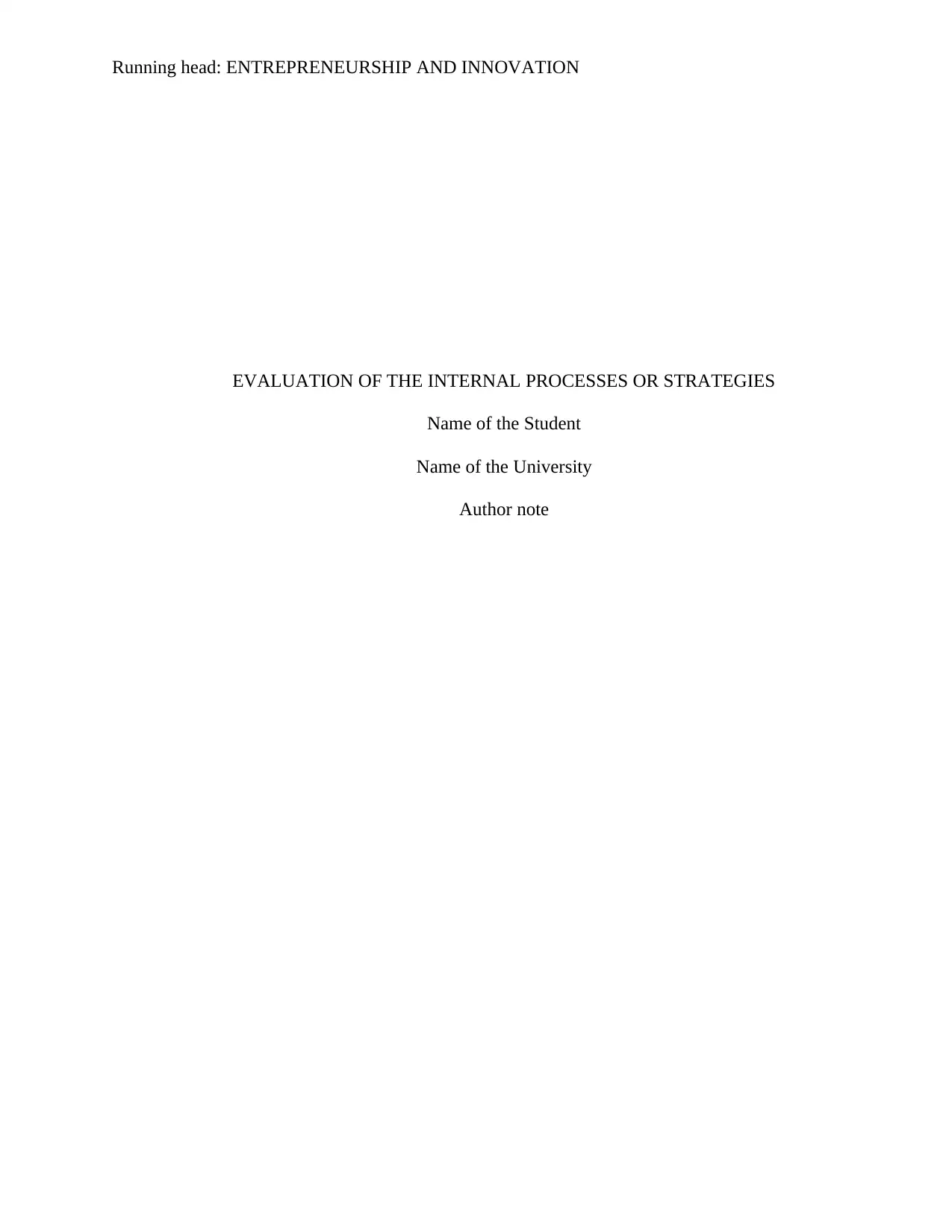
Running head: ENTREPRENEURSHIP AND INNOVATION
EVALUATION OF THE INTERNAL PROCESSES OR STRATEGIES
Name of the Student
Name of the University
Author note
EVALUATION OF THE INTERNAL PROCESSES OR STRATEGIES
Name of the Student
Name of the University
Author note
Paraphrase This Document
Need a fresh take? Get an instant paraphrase of this document with our AI Paraphraser
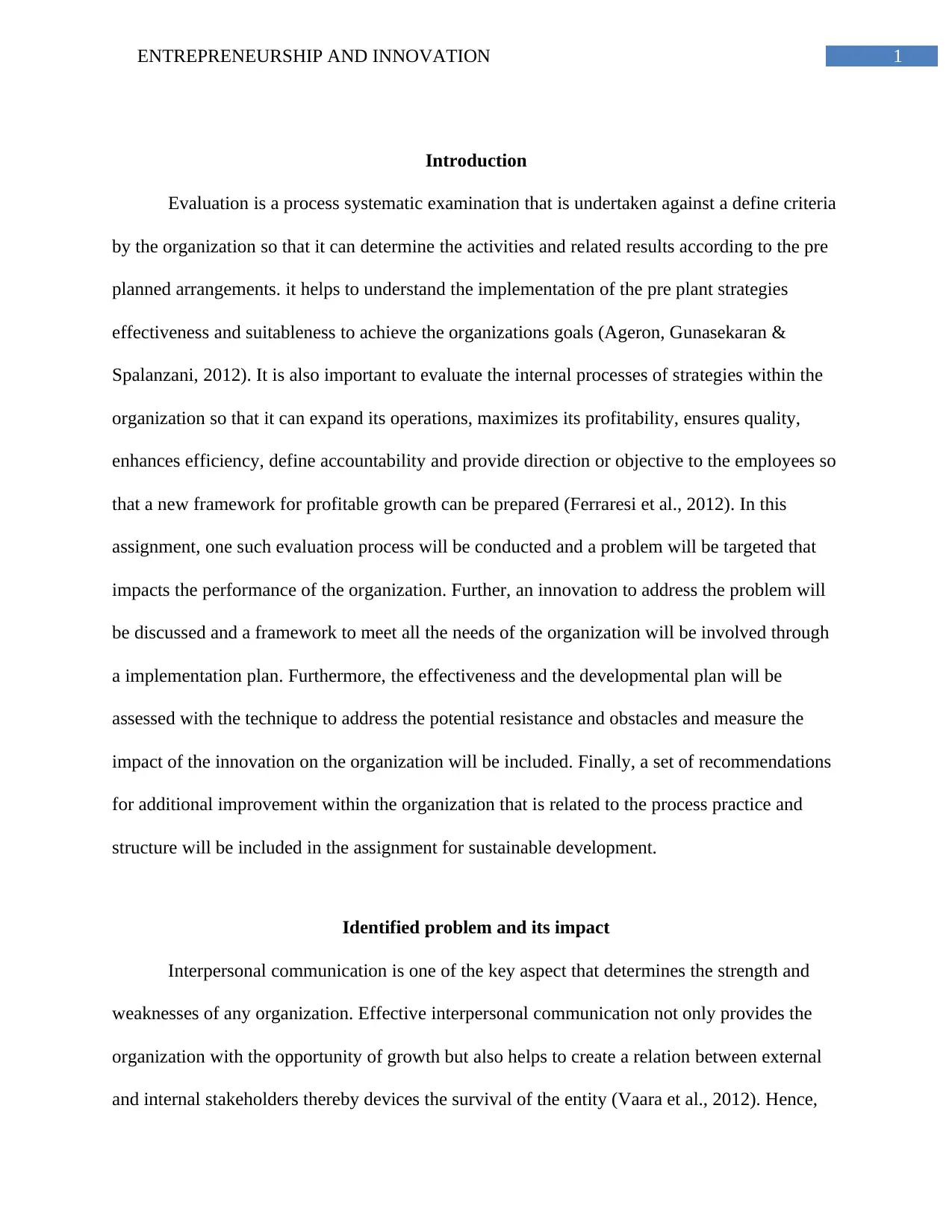
1ENTREPRENEURSHIP AND INNOVATION
Introduction
Evaluation is a process systematic examination that is undertaken against a define criteria
by the organization so that it can determine the activities and related results according to the pre
planned arrangements. it helps to understand the implementation of the pre plant strategies
effectiveness and suitableness to achieve the organizations goals (Ageron, Gunasekaran &
Spalanzani, 2012). It is also important to evaluate the internal processes of strategies within the
organization so that it can expand its operations, maximizes its profitability, ensures quality,
enhances efficiency, define accountability and provide direction or objective to the employees so
that a new framework for profitable growth can be prepared (Ferraresi et al., 2012). In this
assignment, one such evaluation process will be conducted and a problem will be targeted that
impacts the performance of the organization. Further, an innovation to address the problem will
be discussed and a framework to meet all the needs of the organization will be involved through
a implementation plan. Furthermore, the effectiveness and the developmental plan will be
assessed with the technique to address the potential resistance and obstacles and measure the
impact of the innovation on the organization will be included. Finally, a set of recommendations
for additional improvement within the organization that is related to the process practice and
structure will be included in the assignment for sustainable development.
Identified problem and its impact
Interpersonal communication is one of the key aspect that determines the strength and
weaknesses of any organization. Effective interpersonal communication not only provides the
organization with the opportunity of growth but also helps to create a relation between external
and internal stakeholders thereby devices the survival of the entity (Vaara et al., 2012). Hence,
Introduction
Evaluation is a process systematic examination that is undertaken against a define criteria
by the organization so that it can determine the activities and related results according to the pre
planned arrangements. it helps to understand the implementation of the pre plant strategies
effectiveness and suitableness to achieve the organizations goals (Ageron, Gunasekaran &
Spalanzani, 2012). It is also important to evaluate the internal processes of strategies within the
organization so that it can expand its operations, maximizes its profitability, ensures quality,
enhances efficiency, define accountability and provide direction or objective to the employees so
that a new framework for profitable growth can be prepared (Ferraresi et al., 2012). In this
assignment, one such evaluation process will be conducted and a problem will be targeted that
impacts the performance of the organization. Further, an innovation to address the problem will
be discussed and a framework to meet all the needs of the organization will be involved through
a implementation plan. Furthermore, the effectiveness and the developmental plan will be
assessed with the technique to address the potential resistance and obstacles and measure the
impact of the innovation on the organization will be included. Finally, a set of recommendations
for additional improvement within the organization that is related to the process practice and
structure will be included in the assignment for sustainable development.
Identified problem and its impact
Interpersonal communication is one of the key aspect that determines the strength and
weaknesses of any organization. Effective interpersonal communication not only provides the
organization with the opportunity of growth but also helps to create a relation between external
and internal stakeholders thereby devices the survival of the entity (Vaara et al., 2012). Hence,
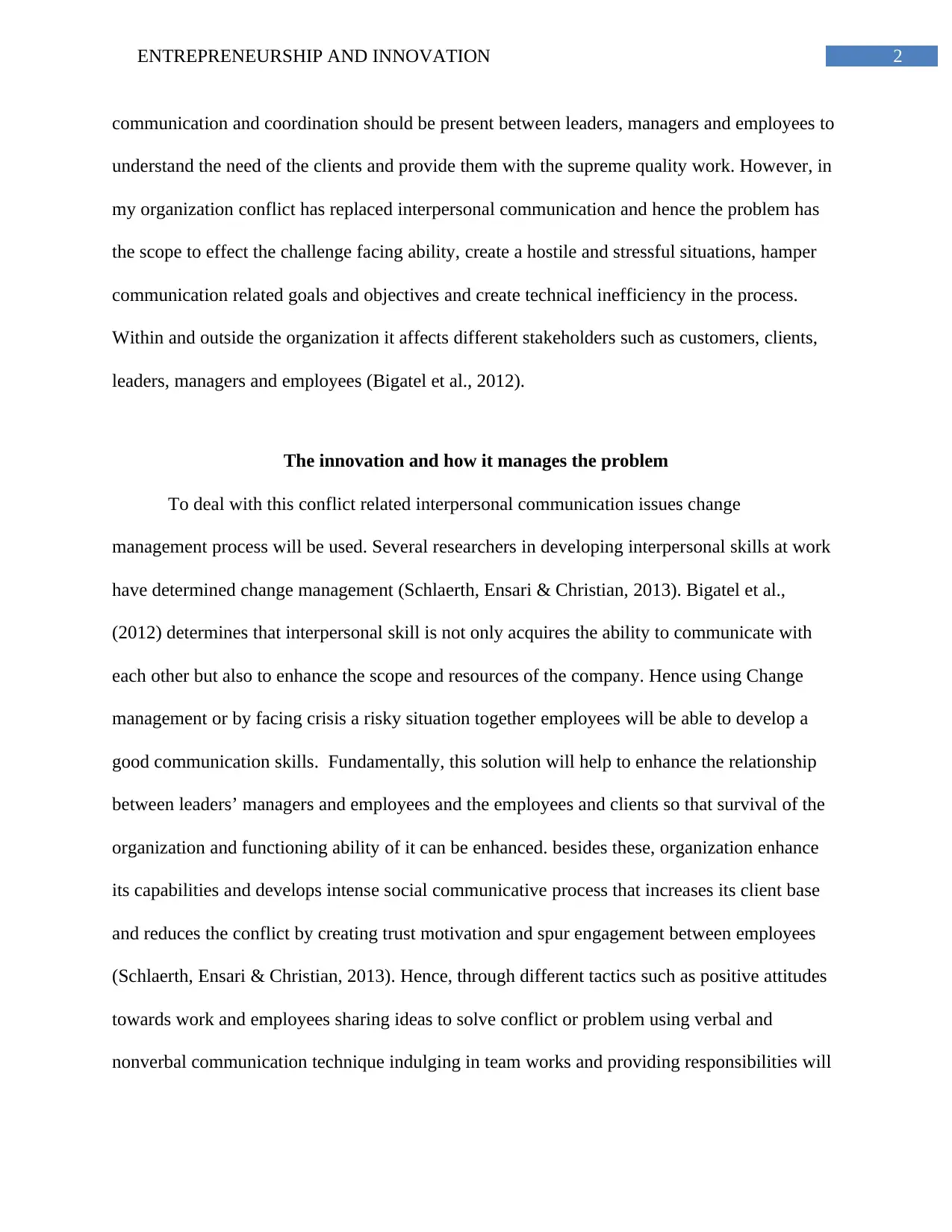
2ENTREPRENEURSHIP AND INNOVATION
communication and coordination should be present between leaders, managers and employees to
understand the need of the clients and provide them with the supreme quality work. However, in
my organization conflict has replaced interpersonal communication and hence the problem has
the scope to effect the challenge facing ability, create a hostile and stressful situations, hamper
communication related goals and objectives and create technical inefficiency in the process.
Within and outside the organization it affects different stakeholders such as customers, clients,
leaders, managers and employees (Bigatel et al., 2012).
The innovation and how it manages the problem
To deal with this conflict related interpersonal communication issues change
management process will be used. Several researchers in developing interpersonal skills at work
have determined change management (Schlaerth, Ensari & Christian, 2013). Bigatel et al.,
(2012) determines that interpersonal skill is not only acquires the ability to communicate with
each other but also to enhance the scope and resources of the company. Hence using Change
management or by facing crisis a risky situation together employees will be able to develop a
good communication skills. Fundamentally, this solution will help to enhance the relationship
between leaders’ managers and employees and the employees and clients so that survival of the
organization and functioning ability of it can be enhanced. besides these, organization enhance
its capabilities and develops intense social communicative process that increases its client base
and reduces the conflict by creating trust motivation and spur engagement between employees
(Schlaerth, Ensari & Christian, 2013). Hence, through different tactics such as positive attitudes
towards work and employees sharing ideas to solve conflict or problem using verbal and
nonverbal communication technique indulging in team works and providing responsibilities will
communication and coordination should be present between leaders, managers and employees to
understand the need of the clients and provide them with the supreme quality work. However, in
my organization conflict has replaced interpersonal communication and hence the problem has
the scope to effect the challenge facing ability, create a hostile and stressful situations, hamper
communication related goals and objectives and create technical inefficiency in the process.
Within and outside the organization it affects different stakeholders such as customers, clients,
leaders, managers and employees (Bigatel et al., 2012).
The innovation and how it manages the problem
To deal with this conflict related interpersonal communication issues change
management process will be used. Several researchers in developing interpersonal skills at work
have determined change management (Schlaerth, Ensari & Christian, 2013). Bigatel et al.,
(2012) determines that interpersonal skill is not only acquires the ability to communicate with
each other but also to enhance the scope and resources of the company. Hence using Change
management or by facing crisis a risky situation together employees will be able to develop a
good communication skills. Fundamentally, this solution will help to enhance the relationship
between leaders’ managers and employees and the employees and clients so that survival of the
organization and functioning ability of it can be enhanced. besides these, organization enhance
its capabilities and develops intense social communicative process that increases its client base
and reduces the conflict by creating trust motivation and spur engagement between employees
(Schlaerth, Ensari & Christian, 2013). Hence, through different tactics such as positive attitudes
towards work and employees sharing ideas to solve conflict or problem using verbal and
nonverbal communication technique indulging in team works and providing responsibilities will
⊘ This is a preview!⊘
Do you want full access?
Subscribe today to unlock all pages.

Trusted by 1+ million students worldwide
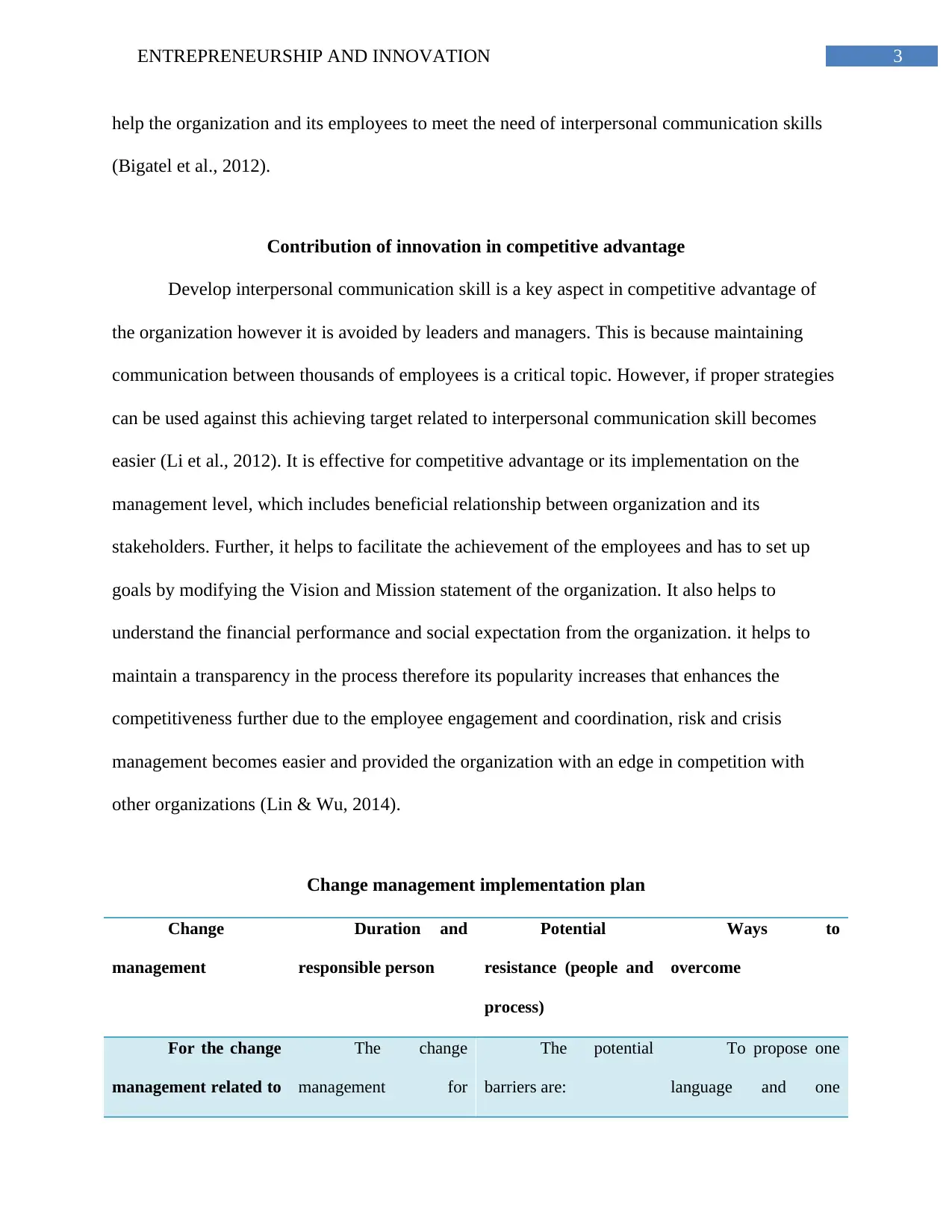
3ENTREPRENEURSHIP AND INNOVATION
help the organization and its employees to meet the need of interpersonal communication skills
(Bigatel et al., 2012).
Contribution of innovation in competitive advantage
Develop interpersonal communication skill is a key aspect in competitive advantage of
the organization however it is avoided by leaders and managers. This is because maintaining
communication between thousands of employees is a critical topic. However, if proper strategies
can be used against this achieving target related to interpersonal communication skill becomes
easier (Li et al., 2012). It is effective for competitive advantage or its implementation on the
management level, which includes beneficial relationship between organization and its
stakeholders. Further, it helps to facilitate the achievement of the employees and has to set up
goals by modifying the Vision and Mission statement of the organization. It also helps to
understand the financial performance and social expectation from the organization. it helps to
maintain a transparency in the process therefore its popularity increases that enhances the
competitiveness further due to the employee engagement and coordination, risk and crisis
management becomes easier and provided the organization with an edge in competition with
other organizations (Lin & Wu, 2014).
Change management implementation plan
Change
management
Duration and
responsible person
Potential
resistance (people and
process)
Ways to
overcome
For the change
management related to
The change
management for
The potential
barriers are:
To propose one
language and one
help the organization and its employees to meet the need of interpersonal communication skills
(Bigatel et al., 2012).
Contribution of innovation in competitive advantage
Develop interpersonal communication skill is a key aspect in competitive advantage of
the organization however it is avoided by leaders and managers. This is because maintaining
communication between thousands of employees is a critical topic. However, if proper strategies
can be used against this achieving target related to interpersonal communication skill becomes
easier (Li et al., 2012). It is effective for competitive advantage or its implementation on the
management level, which includes beneficial relationship between organization and its
stakeholders. Further, it helps to facilitate the achievement of the employees and has to set up
goals by modifying the Vision and Mission statement of the organization. It also helps to
understand the financial performance and social expectation from the organization. it helps to
maintain a transparency in the process therefore its popularity increases that enhances the
competitiveness further due to the employee engagement and coordination, risk and crisis
management becomes easier and provided the organization with an edge in competition with
other organizations (Lin & Wu, 2014).
Change management implementation plan
Change
management
Duration and
responsible person
Potential
resistance (people and
process)
Ways to
overcome
For the change
management related to
The change
management for
The potential
barriers are:
To propose one
language and one
Paraphrase This Document
Need a fresh take? Get an instant paraphrase of this document with our AI Paraphraser
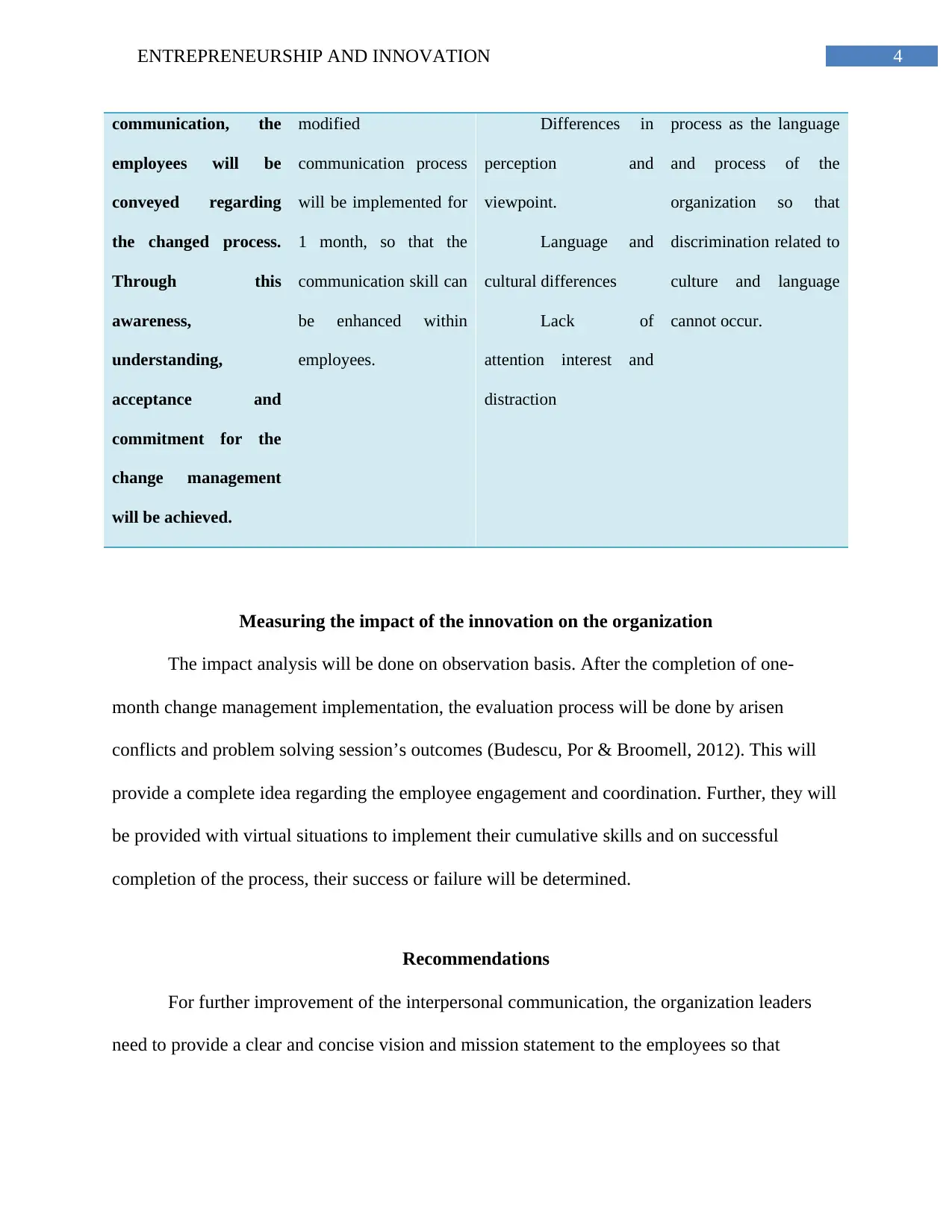
4ENTREPRENEURSHIP AND INNOVATION
communication, the
employees will be
conveyed regarding
the changed process.
Through this
awareness,
understanding,
acceptance and
commitment for the
change management
will be achieved.
modified
communication process
will be implemented for
1 month, so that the
communication skill can
be enhanced within
employees.
Differences in
perception and
viewpoint.
Language and
cultural differences
Lack of
attention interest and
distraction
process as the language
and process of the
organization so that
discrimination related to
culture and language
cannot occur.
Measuring the impact of the innovation on the organization
The impact analysis will be done on observation basis. After the completion of one-
month change management implementation, the evaluation process will be done by arisen
conflicts and problem solving session’s outcomes (Budescu, Por & Broomell, 2012). This will
provide a complete idea regarding the employee engagement and coordination. Further, they will
be provided with virtual situations to implement their cumulative skills and on successful
completion of the process, their success or failure will be determined.
Recommendations
For further improvement of the interpersonal communication, the organization leaders
need to provide a clear and concise vision and mission statement to the employees so that
communication, the
employees will be
conveyed regarding
the changed process.
Through this
awareness,
understanding,
acceptance and
commitment for the
change management
will be achieved.
modified
communication process
will be implemented for
1 month, so that the
communication skill can
be enhanced within
employees.
Differences in
perception and
viewpoint.
Language and
cultural differences
Lack of
attention interest and
distraction
process as the language
and process of the
organization so that
discrimination related to
culture and language
cannot occur.
Measuring the impact of the innovation on the organization
The impact analysis will be done on observation basis. After the completion of one-
month change management implementation, the evaluation process will be done by arisen
conflicts and problem solving session’s outcomes (Budescu, Por & Broomell, 2012). This will
provide a complete idea regarding the employee engagement and coordination. Further, they will
be provided with virtual situations to implement their cumulative skills and on successful
completion of the process, their success or failure will be determined.
Recommendations
For further improvement of the interpersonal communication, the organization leaders
need to provide a clear and concise vision and mission statement to the employees so that
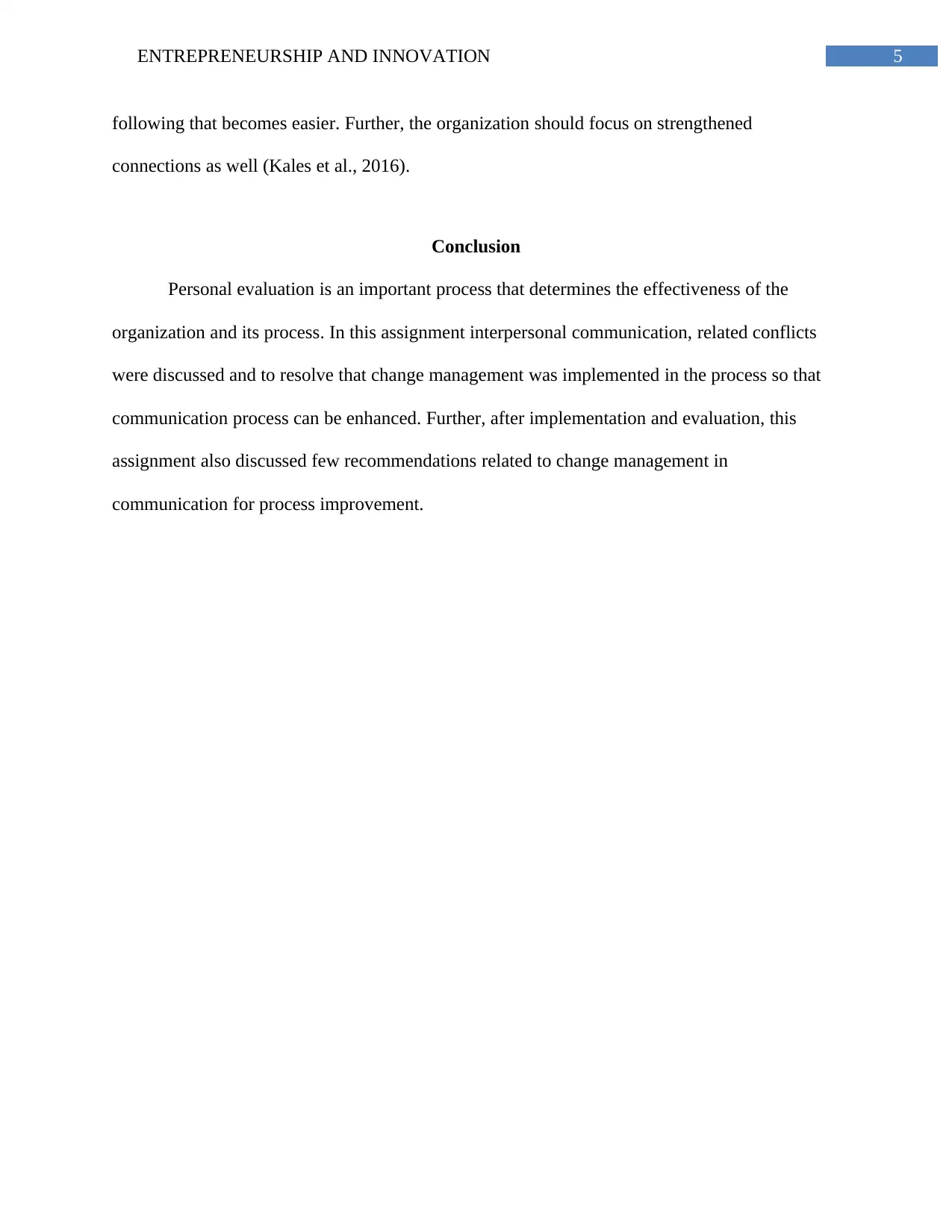
5ENTREPRENEURSHIP AND INNOVATION
following that becomes easier. Further, the organization should focus on strengthened
connections as well (Kales et al., 2016).
Conclusion
Personal evaluation is an important process that determines the effectiveness of the
organization and its process. In this assignment interpersonal communication, related conflicts
were discussed and to resolve that change management was implemented in the process so that
communication process can be enhanced. Further, after implementation and evaluation, this
assignment also discussed few recommendations related to change management in
communication for process improvement.
following that becomes easier. Further, the organization should focus on strengthened
connections as well (Kales et al., 2016).
Conclusion
Personal evaluation is an important process that determines the effectiveness of the
organization and its process. In this assignment interpersonal communication, related conflicts
were discussed and to resolve that change management was implemented in the process so that
communication process can be enhanced. Further, after implementation and evaluation, this
assignment also discussed few recommendations related to change management in
communication for process improvement.
⊘ This is a preview!⊘
Do you want full access?
Subscribe today to unlock all pages.

Trusted by 1+ million students worldwide
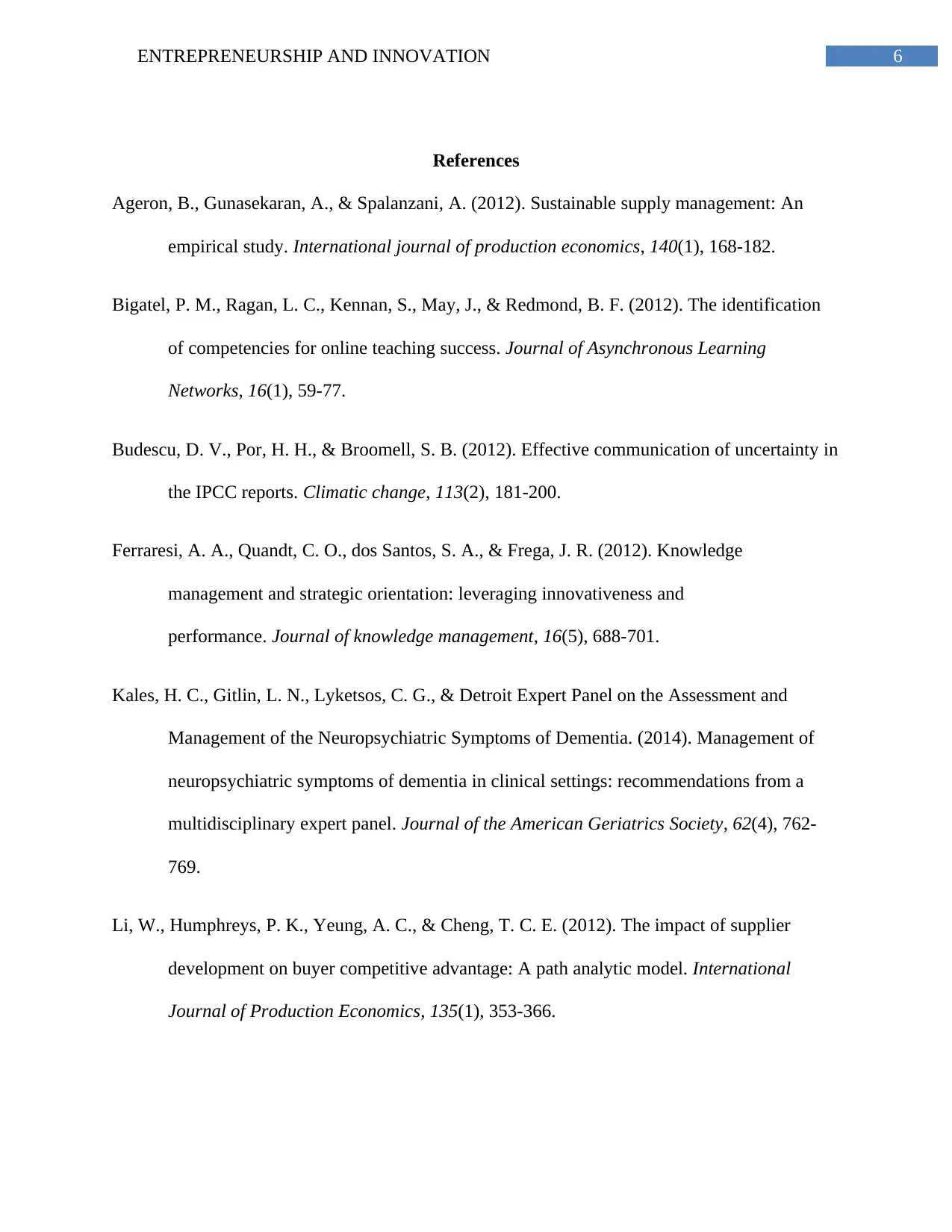
6ENTREPRENEURSHIP AND INNOVATION
References
Ageron, B., Gunasekaran, A., & Spalanzani, A. (2012). Sustainable supply management: An
empirical study. International journal of production economics, 140(1), 168-182.
Bigatel, P. M., Ragan, L. C., Kennan, S., May, J., & Redmond, B. F. (2012). The identification
of competencies for online teaching success. Journal of Asynchronous Learning
Networks, 16(1), 59-77.
Budescu, D. V., Por, H. H., & Broomell, S. B. (2012). Effective communication of uncertainty in
the IPCC reports. Climatic change, 113(2), 181-200.
Ferraresi, A. A., Quandt, C. O., dos Santos, S. A., & Frega, J. R. (2012). Knowledge
management and strategic orientation: leveraging innovativeness and
performance. Journal of knowledge management, 16(5), 688-701.
Kales, H. C., Gitlin, L. N., Lyketsos, C. G., & Detroit Expert Panel on the Assessment and
Management of the Neuropsychiatric Symptoms of Dementia. (2014). Management of
neuropsychiatric symptoms of dementia in clinical settings: recommendations from a
multidisciplinary expert panel. Journal of the American Geriatrics Society, 62(4), 762-
769.
Li, W., Humphreys, P. K., Yeung, A. C., & Cheng, T. C. E. (2012). The impact of supplier
development on buyer competitive advantage: A path analytic model. International
Journal of Production Economics, 135(1), 353-366.
References
Ageron, B., Gunasekaran, A., & Spalanzani, A. (2012). Sustainable supply management: An
empirical study. International journal of production economics, 140(1), 168-182.
Bigatel, P. M., Ragan, L. C., Kennan, S., May, J., & Redmond, B. F. (2012). The identification
of competencies for online teaching success. Journal of Asynchronous Learning
Networks, 16(1), 59-77.
Budescu, D. V., Por, H. H., & Broomell, S. B. (2012). Effective communication of uncertainty in
the IPCC reports. Climatic change, 113(2), 181-200.
Ferraresi, A. A., Quandt, C. O., dos Santos, S. A., & Frega, J. R. (2012). Knowledge
management and strategic orientation: leveraging innovativeness and
performance. Journal of knowledge management, 16(5), 688-701.
Kales, H. C., Gitlin, L. N., Lyketsos, C. G., & Detroit Expert Panel on the Assessment and
Management of the Neuropsychiatric Symptoms of Dementia. (2014). Management of
neuropsychiatric symptoms of dementia in clinical settings: recommendations from a
multidisciplinary expert panel. Journal of the American Geriatrics Society, 62(4), 762-
769.
Li, W., Humphreys, P. K., Yeung, A. C., & Cheng, T. C. E. (2012). The impact of supplier
development on buyer competitive advantage: A path analytic model. International
Journal of Production Economics, 135(1), 353-366.
Paraphrase This Document
Need a fresh take? Get an instant paraphrase of this document with our AI Paraphraser
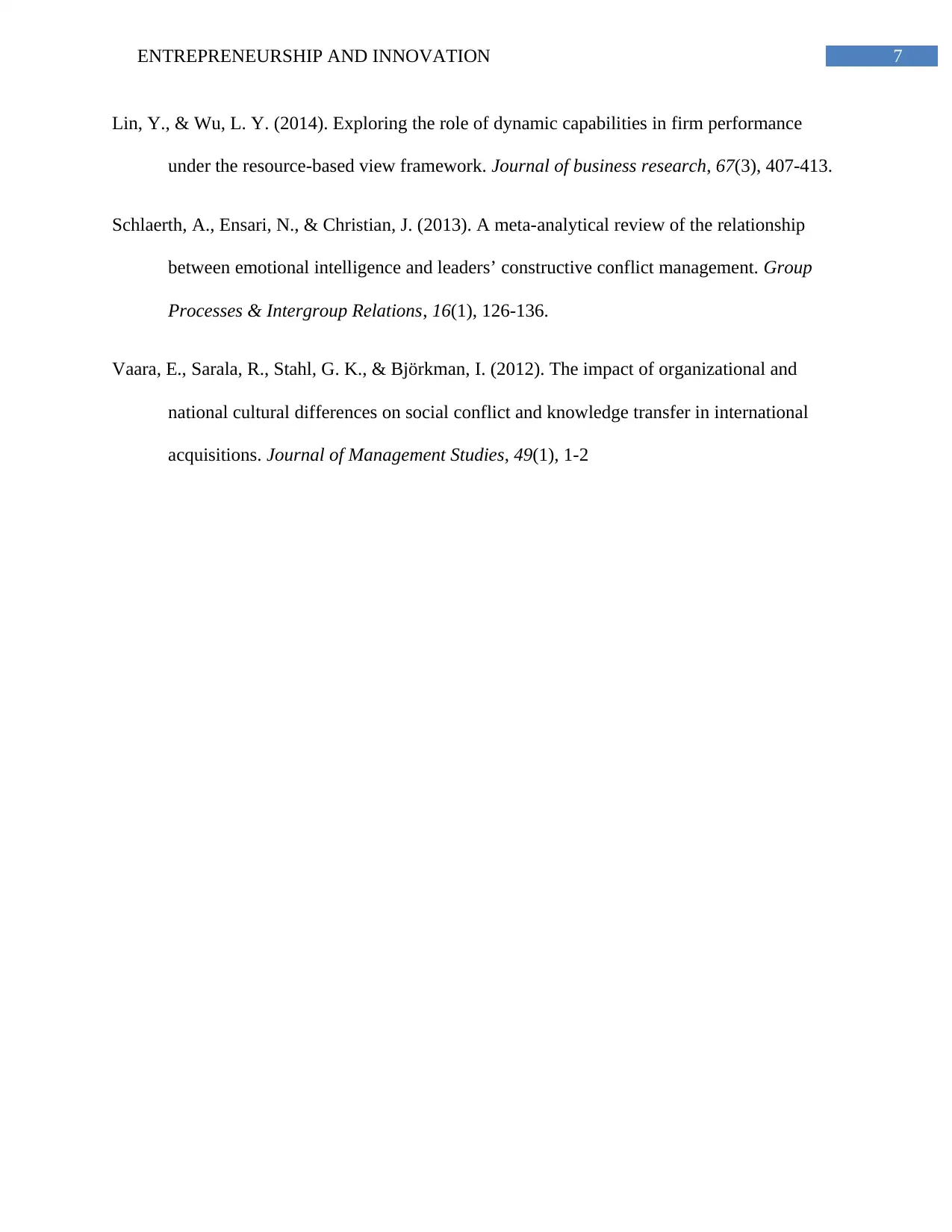
7ENTREPRENEURSHIP AND INNOVATION
Lin, Y., & Wu, L. Y. (2014). Exploring the role of dynamic capabilities in firm performance
under the resource-based view framework. Journal of business research, 67(3), 407-413.
Schlaerth, A., Ensari, N., & Christian, J. (2013). A meta-analytical review of the relationship
between emotional intelligence and leaders’ constructive conflict management. Group
Processes & Intergroup Relations, 16(1), 126-136.
Vaara, E., Sarala, R., Stahl, G. K., & Björkman, I. (2012). The impact of organizational and
national cultural differences on social conflict and knowledge transfer in international
acquisitions. Journal of Management Studies, 49(1), 1-2
Lin, Y., & Wu, L. Y. (2014). Exploring the role of dynamic capabilities in firm performance
under the resource-based view framework. Journal of business research, 67(3), 407-413.
Schlaerth, A., Ensari, N., & Christian, J. (2013). A meta-analytical review of the relationship
between emotional intelligence and leaders’ constructive conflict management. Group
Processes & Intergroup Relations, 16(1), 126-136.
Vaara, E., Sarala, R., Stahl, G. K., & Björkman, I. (2012). The impact of organizational and
national cultural differences on social conflict and knowledge transfer in international
acquisitions. Journal of Management Studies, 49(1), 1-2

8ENTREPRENEURSHIP AND INNOVATION
⊘ This is a preview!⊘
Do you want full access?
Subscribe today to unlock all pages.

Trusted by 1+ million students worldwide
1 out of 9
Related Documents
Your All-in-One AI-Powered Toolkit for Academic Success.
+13062052269
info@desklib.com
Available 24*7 on WhatsApp / Email
![[object Object]](/_next/static/media/star-bottom.7253800d.svg)
Unlock your academic potential
Copyright © 2020–2025 A2Z Services. All Rights Reserved. Developed and managed by ZUCOL.





